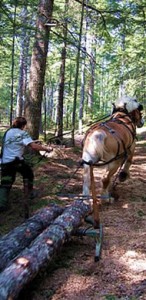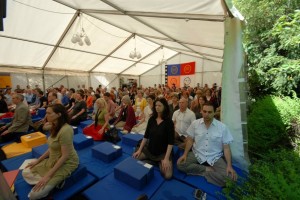Monday
Featured StoriesA History of Sustainability in Shambhala
By David Wimberly
In the Beginning
The primordial genesis of Shambhala arose out of the ecology of Tibet, a particularly unforgiving and fierce environment. Bon and even pre-Bon cultures recognized the need for balance in human existence with other life. Dawa Sangpo brought to Tibet the Buddha’s teachings on ruling an enlightened kingdom, protecting its treasures in brilliant harmony with nature—self-sufficient, sustainable for millenia. The Mahasiddha Padmasambhava tamed not just humans but also the alive energies of the earth itself. From these sparks Tibetan civilization arose, uniquely based on enlightened compassion, egolessness, wisdom, and interdependence. Stewarding unspoiled its great rivers and ecology, Tibet nourished the lands around its mountain crown, particularly benefitting vast numbers of beings in China, India and Indochina.
Modern Western History
Shambhala came to the West with the Mahasiddha Chogyam Trungpa in the 1970s. This was the time of Vietnam, mass protests, assassinations. Hippies, peaceniks, students and activists were magnetized. When Alan Ginsburg wanted to lead protests in 1974 at the Rocky Flats nuclear weapons facility near Boulder, Colorado, Trungpa Rinpoche told him first practice and study more to learn how to make lasting, profound change. Ginsburg persisted but the message proved well made and remembered. Naropa University provided early leadership in sustainability with innovative programs still evolving today. In 1976 seminal thinker Gregory Bateson, author of “Steps to An Ecology of Mind” brilliantly taught there.
Important to the future development of Shambhala has been the wholehearted love of nature in our leaders. Chogyam Trungpa used loving imagery of all of life and taught us the absolute sacredness of life. He established Kami shrines to bring down the elemental spirits of nature and taught kasung to encamp in the open. His Holiness the 16th Gyalwang Karmapa loved birds in particular. In 1976, the future Sakyong learned the ancient royal art of falconry; his devotion to all living beings seems to come naturally.
Nova Scotia
The 1987 Parinirvana of Chogyam Trungpa triggered massive inspiration among faithful students to realize the vision of their root guru and exodus to Nova Scotia, the heart of Kalapa. The relatively unspoiled nature there of earth, sea and sky nourishes a primordial connection to the vivid, alive quality of a particular, powerful magical world.
Environmental activism arose within the Nova Scotia sangha in the late 1980s and 1990s. The St. Margaret’s Area Recycling Team and the It’s Not Garbage coalition were influential groups co-founded by sangha, including me. Warrior General Marty Janowitz took leadership of the Clean Nova Scotia Foundation. All this lead to innovative recycling, composting and waste reduction programs that still pilot the world.
The Halifax Ecology Action Centre boasts sangha on its board. Genuine Progress Index Atlantic has pioneered innovative ways of bringing the value of our lives and world beyond materialism into the evaluation process of government, industry and the public. Windhorse Farm shows how to sustainably garden and harvest woodland with absolute respect for other sentient beings. These are but some of the many examples of early environmental leadership. Much, much more is happening elsewhere as well.
Further Evolution
Gradually a changed happened as we became more seasoned in our meditation practice and our living expression of Shambhala teachings. With the arrival of the inaugural 2003 Shambhala Congress social action emerged as a hot priority. The Environmental Workshop there created “A Declaration of Environmental Aspirations,” with one focus group there formally making the first supplication for a Sadhana for the Earth, to which the Sakyong happily agreed. The Social Action Advisory Group for Shambhala was formed with environment prominent among its topics.
This led to Shambhala Path of Social Action programs at Dechen Choling and Dorje Denma Ling. A related program is still offered by Fleet Maul. Participants at the Dorje Denma Ling program again supplicated the Sakyong with a message delivered to Sakyong Mipham at Shambhala Mountain Center, followed auspiciously by magical events manifested in the Shambhala Buddhist ngondro and path as such. With such coincidence we like to think our aspirations were instrumental, particularly with the Shambhala Path of Social Service comprising an essential part of this new beginning. The Social Action Advisory Group helped implement that, including our documents as resources. At the first Rigden Abhisheka at SMC, social engagement and action formally entered our path.
Throughout the Shambhala mandala, sangha increasingly give priority to environmental responsibility. Land centers are all showing real leadership both in action and in programs offered. Shambhala Mountain has innovative landscaping, wastewater and gardening. Karme Choling has a particularly outstanding gardening program. Dorje Denma Ling has renovated using geothermal heat. Urban centers are increasingly helping, such as the Halifax Shambhala Sustainability Initiative which has generously adapted The Natural Step process into a template available to other centers.
Sadhana for the Earth
The 2007 Earth Day Supplication to the Sakyong for the Sadhana for the Earth was inspirational in bringing environment to the top of the agenda at the third Shambhala Congress. The Touching the Earth Working Group emerged. Mandala wide environmental action in relating to the global climate change catastrophe became one of the top two priorities of the Sakyong’s Council.
Sakyong Mipham has confirmed that a living, vibrantly healthy, sustainable environment will be taught as essential. With further unfolding of the Shambhala Buddhist path, sustainable environment now becomes even more strongly central to the vividly alive sacred world of Shambhala. The Sadhana for the Earth could be a core practice to help inspire ourselves and open outward the Shambhala teachings to immense benefit to all sentient beings in a future desperately in need.
 David Wimberly knew from a rural childhood his great aspiration to help the animals and plants of our world, particularly hawks and falcons. In 1974 he helped establish a research center in Costa Rica on sustainable agriculture and aquaculture that stimulated a cooperative movement there. In 1976 David taught falconry to the Sakyong. David’s work as Co-Coordinator of The It’s Not Garbage Coalition (and numerous other groups) was pivotal in Nova Scotia’s use of clean composting as core to its Waste/Resource management system, often hailed as best in the world. David played core roles in stopping garbage, PCB and sewage sludge incinerators, yet always promoted sustainable alternatives. He aspires to helping find expressions of the Shambhala teachings to benefit all sentient beings, particularly in ways to help all people see their world as fully alive and to make decisions from a sane and awakened mind.
David Wimberly knew from a rural childhood his great aspiration to help the animals and plants of our world, particularly hawks and falcons. In 1974 he helped establish a research center in Costa Rica on sustainable agriculture and aquaculture that stimulated a cooperative movement there. In 1976 David taught falconry to the Sakyong. David’s work as Co-Coordinator of The It’s Not Garbage Coalition (and numerous other groups) was pivotal in Nova Scotia’s use of clean composting as core to its Waste/Resource management system, often hailed as best in the world. David played core roles in stopping garbage, PCB and sewage sludge incinerators, yet always promoted sustainable alternatives. He aspires to helping find expressions of the Shambhala teachings to benefit all sentient beings, particularly in ways to help all people see their world as fully alive and to make decisions from a sane and awakened mind.









May 31, 2009
Reply
lovely article